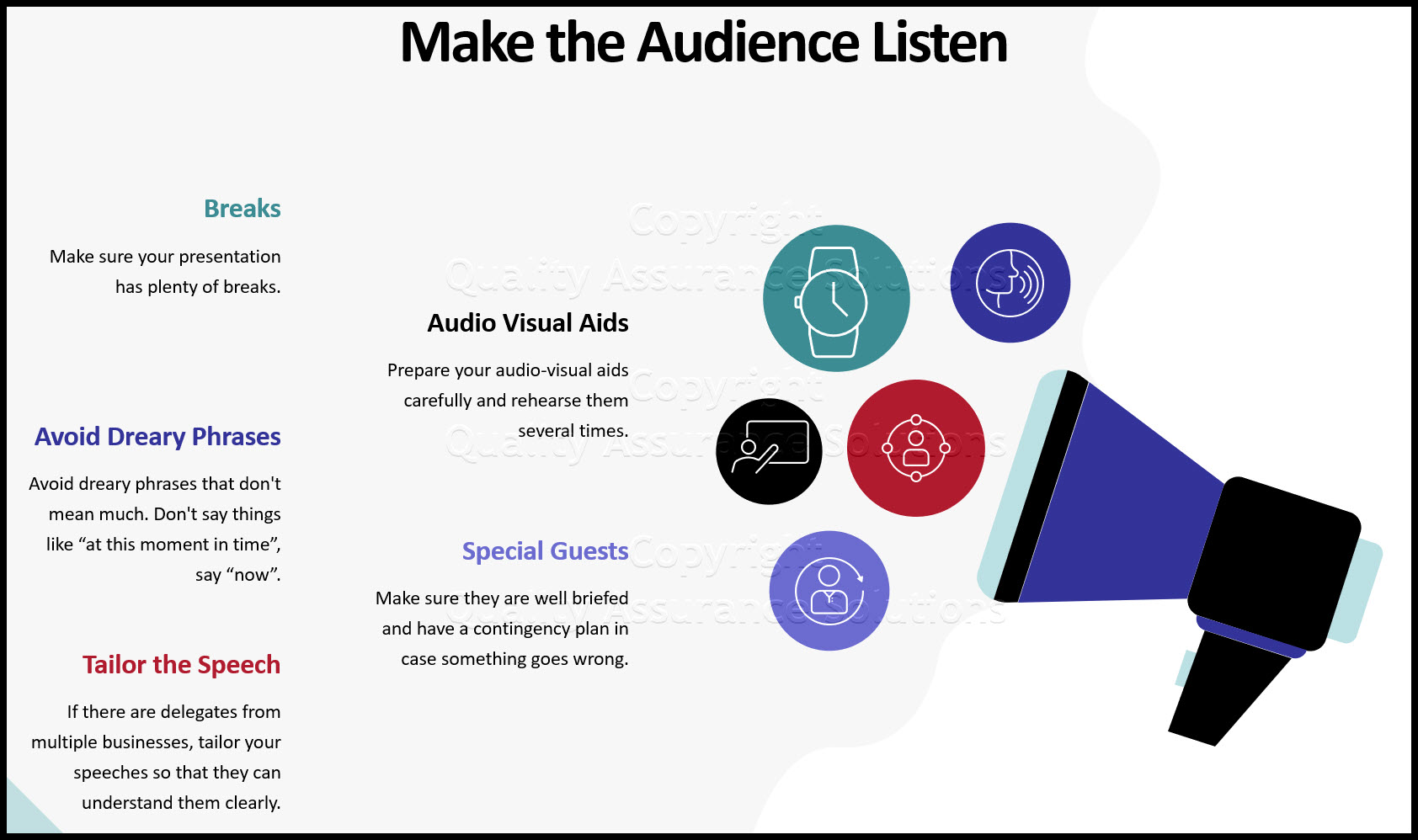Tips To Public Speaking
Discover tips to public speaking with this article. If you want more tips, please sign up for QA Solutions E-zine and download our full 60 page report on How to Speak in Public...With Confidence.
Preparation Tips to Public Speaking
There are 3 questions to ask before you write your talk. Answer these questions to focus your mind on your subject and your audience.
This in turn helps you write a clear, relevant, and easy to follow presentation. If you give regular talks and presentations, print the questions on a blank form, copy it, and fill it in each time you prepare a new presentation.
Now brainstorm everything you can think of to say and write it all down, along with possible visual aids and back up material, ideas for analogies and examples, and so on. Then check everything against the questions to see if you really need to include it. Consider in particular whether it contributes to the purpose of the talk.
1. Why am I talking?
2. Who am I talking to?
- Age Range.
- 'Status' range.
- What do they already know about the subject?
- Do they have any specialist knowledge?
- Do they want exact details or general principles?
- Will they have chosen to attend or been told to?
- What is their likely attitude to the subject?
- What will they want to do with the information?
3. What is the purpose of the talk? At the end of the presentation I want the audience to know/chose to/want etc.
TrainingKeeper Software. Keep, organize and plan all your employees' training and activities. Software includes multi-user support with reports, certs, and calendars.
Three Things To Remember with an Invitation
You may be terrified at the prospect of standing up in front of a crowd of strangers and speaking intelligently and coherently for a given time. But remember; if you turn down this invitation, you may never get the chance again to impress your brilliance and expertise on this room full of business opportunity. So follow these tips to public speaking to make your speech successful, without making a fool of yourself:
Allow yourself plenty of time to prepare your material. For a script that lasts around 20 minutes, expect to take around 10 hours to research and write your first draft. Get someone else to comment, then you could need another three or four hours to rewrite - be prepared.
For tips to public speaking, make sure your speech uses a good, attention grabbing beginning. Don't rush into words immediately. Pause to let your audience settle down after you have been introduced. Don't be tempted to start with "Thank you for inviting me" -no one remembers you for saying that! Instead, structure your opening remarks to outline the shape of the speech and lead your ideas on.
At the end, sum the speech up. If you can think of a good catch line to end on, all the better.
Thoroughly check all the factors - Ask about the facilities at the venue. Don't be afraid to ring in advance to check on electric points for projectors, overhead visuals etc. Define seating arrangements and how many people are expected to attend. Find out the type of expected audience and target your words to suit them.
8D Manager Software with 8D, 9D, 5Y and 4M report generator. Your corrective action software for managing, measuring, and reporting issues.
Make Your Audience Hears Your Message
Even an audience with genuine
interest and attention can leave a talk or seminar with a distorted memory of your message. The things that stand out in their minds may not be your impressive talking
points. Use these tips to public speaking to make
sure that they remember your desired message.
Reinforce the key points by:
- Repeating them frequently - in introductions and summaries as well as the main body of the talk
- Using examples to highlight them and make the concept more concrete, and therefore more memorable - and asking the audience to suggest examples themselves
- Backing them up with written handout material.
Visual illustrations are more memorable than verbal ones; a combination of both is strongest of all. So back up your key points with strong visual images - slides, OHPs, props or whatever. Don't give such a strong emphasis to your minor points, or the audience will misinterpret their importance. You can still use visual images to support these points, but make them less striking.
Most importantly, when you prepare any talk or presentation, ask yourself this question: “If the audience only remembers one point afterwards, which one point is it?” Once you know the answer, make this and the last thing you say to them - because those are the most memorable moments.
Employee Handbook Kit includes two Employee Handbook templates for Professional & Manufacturing. Includes over 60 policies and benefits templates.
5 Ways to Keep Your Audience Listening
- Make sure your presentation or conference has plenty of breaks. Keep conference sessions to an hour or less, followed by a break of at least fifteen minutes.
- Avoid dreary phrases that don't mean much. Don't say things like “at this moment in time”, say “now”.
- If there are delegates from more than one country, tailor your speeches so that they can understand them clearly. Avoid phrases and references that will be unfamiliar to them.
- Prepare your audio-visual aids carefully, and rehearse them several times. There is nothing more abysmally amateurish than bad sound, fuzzy pictures and unreadable slides.
- Celebrity guests can be a great success, but watch out! Once they're on stage, they may not say what they are supposed to; make sure they are well briefed, and have a contingency plan in case something goes wrong.
Voice Power
For tips to public speaking, you want to do everything you can to persuade your audience of your point of view. And the most powerful tool at your disposal is your voice. Follow these tips to public speaking to make the most of it:
- It's better to stand up to speak, if you can, as this gives your voice more power and therefore more authority.
- Don't clear your voice before you speak - it gives an amateur feel to the presentation before you've even spoken, which damages your credibility.
- If you slow down your normal speech slightly, and use pauses, then you will come across as more authoritative.
- Use pauses to indicate you have finished a point, and also to create suspense; it indicates that what's coming next is worth listening to.
- Vary the tone and pace of your voice to keep people interested. Choose variations that are relevant - for example, lower your tone (but not the volume) to give the impression you are confiding something confidential. Or jump to a brighter, stronger tone when you switch to a new topic or argument.
- QAS Home
- Public Speaking
|
Quality Assurance Solutions Robert Broughton (805) 419-3344 USA |
 |
|
Software, Videos, Manuals, On-Line Certifications | ||
|
450+ Editable Slides with support links | ||
|
Corrective Action Software | ||
|
Plan and Track Training | ||
|
AQL Inspection Software |
|
Learn and Train TRIZ | ||
|
Editable Template | ||
|
Templates, Guides, QA Manual, Audit Checklists | ||
|
EMS Manual, Procedures, Forms, Examples, Audits, Videos | ||
|
On-Line Accredited Certifications Six Sigma, Risk Management, SCRUM | ||
|
Software, Videos, Manuals, On-Line Certifications |




















